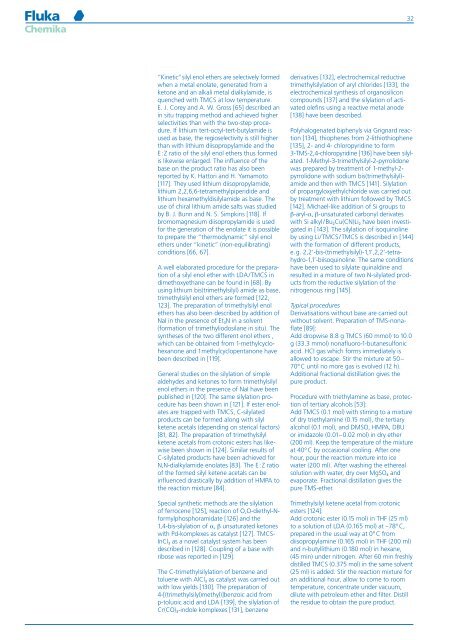Fluka - Sigma-Aldrich
Fluka - Sigma-Aldrich
Fluka - Sigma-Aldrich
Create successful ePaper yourself
Turn your PDF publications into a flip-book with our unique Google optimized e-Paper software.
<strong>Fluka</strong><br />
Chemika<br />
“Kinetic”silyl enol ethers are selectively formed<br />
when a metal enolate, generated from a<br />
ketone and an alkali metal dialkylamide, is<br />
quenched with TMCS at low temperature.<br />
E. J. Corey and A. W. Gross [65] described an<br />
in situ trapping method and achieved higher<br />
selectivities than with the two-step procedure.<br />
If lithium tert-octyl-tert-butylamide is<br />
used as base, the regioselectivity is still higher<br />
than with lithium diisopropylamide and the<br />
E:Z ratio of the silyl enol ethers thus formed<br />
is likewise enlarged. The influence of the<br />
base on the product ratio has also been<br />
reported by K. Hattori and H. Yamamoto<br />
[117]. They used lithium diisopropylamide,<br />
lithium 2,2,6,6-tetramethylpiperidide and<br />
lithium hexamethyldisilylamide as base. The<br />
use of chiral lithium amide salts was studied<br />
by B. J. Bunn and N. S. Simpkins [118]. If<br />
bromomagnesium diisopropylamide is used<br />
for the generation of the enolate it is possible<br />
to prepare the “thermodynamic” silyl enol<br />
ethers under “kinetic” (non-equilibrating)<br />
conditions [66, 67].<br />
A well elaborated procedure for the preparation<br />
of a silyl enol ether with LDA/TMCS in<br />
dimethoxyethane can be found in [68]. By<br />
using lithium bis(trimethylsilyl) amide as base,<br />
trimethylsilyl enol ethers are formed [122,<br />
123]. The preparation of trimethylsilyl enol<br />
ethers has also been described by addition of<br />
NaI in the presence of Et 3N in a solvent<br />
(formation of trimethyliodosilane in situ). The<br />
syntheses of the two different enol ethers ,<br />
which can be obtained from 1-methylcyclohexanone<br />
and 1methylcyclopentanone have<br />
been described in [119].<br />
General studies on the silylation of simple<br />
aldehydes and ketones to form trimethylsilyl<br />
enol ethers in the presence of NaI have been<br />
published in [120]. The same silylation procedure<br />
has been shown in [121]. If ester enolates<br />
are trapped with TMCS, C-silylated<br />
products can be formed along with silyl<br />
ketene acetals (depending on sterical factors)<br />
[81, 82]. The preparation of trimethylsilyl<br />
ketene acetals from crotonic esters has likewise<br />
been shown in [124]. Similar results of<br />
C-silylated products have been achieved for<br />
N,N-dialkylamide enolates [83]. The E:Z ratio<br />
of the formed silyl ketene acetals can be<br />
influenced drastically by addition of HMPA to<br />
the reaction mixture [84].<br />
Special synthetic methods are the silylation<br />
of ferrocene [125], reaction of O,O-diethyl-Nformylphosphoramidate<br />
[126] and the<br />
1,4-bis-silylation of �, � unsaturated ketones<br />
with Pd-komplexes as catalyst [127]. TMCS-<br />
InCl 3 as a novel catalyst system has been<br />
described in [128]. Coupling of a base with<br />
ribose was reported in [129].<br />
The C-trimethylsilylation of benzene and<br />
toluene with AlCl 3 as catalyst was carried out<br />
with low yields [130]. The preparation of<br />
4-[(trimethylsilyl)methyl)]benzoic acid from<br />
p-toluoic acid and LDA [139], the silylation of<br />
Cr(CO) 3-indole komplexes [131], benzene<br />
derivatives [132], electrochemical reductive<br />
trimethylsilylation of aryl chlorides [133], the<br />
electrochemical synthesis of organosilicon<br />
compounds [137] and the silylation of activated<br />
olefins using a reactive metal anode<br />
[138] have been described.<br />
32<br />
Polyhalogenated biphenyls via Grignard reaction<br />
[134], thiophenes from 2-lithiothiophene<br />
[135], 2- and 4- chloropyridine to form<br />
3-TMS-2,4-chloropyridine [136] have been silylated.<br />
1-Methyl-3-trimethylsilyl-2-pyrrolidone<br />
was prepared by treatment of 1-methyl-2pyrrolidone<br />
with sodium bis(trimethylsilyl)amide<br />
and then with TMCS [141]. Silylation<br />
of propargyloxyethylchloride was carried out<br />
by treatment with lithium followed by TMCS<br />
[142]. Michael-like addition of Si groups to<br />
�-aryl-�, �-unsaturated carbonyl derivates<br />
with Si alkyl/Bu 2Cu(CN)Li 2 have been investigated<br />
in [143]. The silylation of isoquinoline<br />
by using Li/TMCS/TMCS is described in [144]<br />
with the formation of different products,<br />
e.g. 2,2’-bis-(trimethylsilyl)-1,1’,2,2’-tetrahydro-1,1’-biisoquinoline.<br />
The same conditions<br />
have been used to silylate quinaldine and<br />
resulted in a mixture of two N-silylated products<br />
from the reductive silylation of the<br />
nitrogenous ring [145].<br />
Typical procedures<br />
Derivatisations without base are carried out<br />
without solvent. Preparation of TMS-nonaflate<br />
[89]:<br />
Add dropwise 8.8 g TMCS (60 mmol) to 10.0<br />
g (33.3 mmol) nonafluoro-1-butanesulfonic<br />
acid. HCl gas which forms immediately is<br />
allowed to escape. Stir the mixture at 50–<br />
70°C until no more gas is evolved (12 h).<br />
Additional fractional distillation gives the<br />
pure product.<br />
Procedure with triethylamine as base, protection<br />
of tertiary alcohols [53]:<br />
Add TMCS (0.1 mol) with stirring to a mixture<br />
of dry triethylamine (0.15 mol), the tertiary<br />
alcohol (0.1 mol), and DMSO, HMPA, DBU<br />
or imidazole (0.01–0.02 mol) in dry ether<br />
(200 ml). Keep the temperature of the mixture<br />
at 40°C by occasional cooling. After one<br />
hour, pour the reaction mixture into ice<br />
water (200 ml). After washing the ethereal<br />
solution with water, dry over MgSO 4 and<br />
evaporate. Fractional distillation gives the<br />
pure TMS-ether.<br />
Trimethylsilyl ketene acetal from crotonic<br />
esters [124]:<br />
Add crotonic ester (0.15 mol) in THF (25 ml)<br />
to a solution of LDA (0.165 mol) at –78°C,<br />
prepared in the usual way at 0°C from<br />
diisopropylamine (0.165 mol) in THF (200 ml)<br />
and n-butyllithium (0.180 mol) in hexane,<br />
(45 min) under nitrogen. After 60 min freshly<br />
distilled TMCS (0.375 mol) in the same solvent<br />
(25 ml) is added. Stir the reaction mixture for<br />
an additional hour, allow to come to room<br />
temperature, concentrate under vacuum,<br />
dilute with petroleum ether and filter. Distill<br />
the residue to obtain the pure product.

















